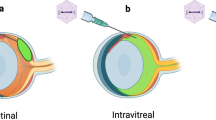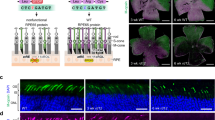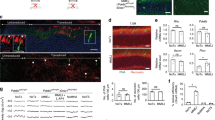Abstract
Mutations in CEP290 are the most common cause of Leber congenital amaurosis (LCA), a severe inherited retinal degenerative disease for which there is currently no cure. Autosomal recessive CEP290-associated LCA is a good candidate for gene replacement therapy, and cells derived from affected individuals give researchers the ability to study human disease and therapeutic gene correction in vitro. Here we report the development of lentiviral vectors carrying full-length CEP290 for the purpose of correcting the CEP290 disease-specific phenotype in human cells. A lentiviral vector containing CMV-driven human full-length CEP290 was constructed. Following transduction of patient-specific, iPSC-derived, photoreceptor precursor cells, reverse transcriptase-PCR analysis and western blotting revealed vector-derived expression. As CEP290 is important in ciliogenesis, the ability of fibroblast cultures from CEP290-associated LCA patients to form cilia was investigated. In cultures derived from these patients, fewer cells formed cilia compared with unaffected controls. Cilia that were formed were shorter in patient-derived cells than in cells from unaffected individuals. Importantly, lentiviral delivery of CEP290 rescued the ciliogenesis defect. The successful construction and viral transfer of full-length CEP290 brings us closer to the goal of providing gene- and cell-based therapies for patients affected with this common form of LCA.
This is a preview of subscription content, access via your institution
Access options
Subscribe to this journal
Receive 12 print issues and online access
$259.00 per year
only $21.58 per issue
Buy this article
- Purchase on Springer Link
- Instant access to full article PDF
Prices may be subject to local taxes which are calculated during checkout






Similar content being viewed by others
References
Coppieters F, Lefever S, Leroy BP, De Baere E . CEP290, a gene with many faces: mutation overview and presentation of CEP290base. Hum Mutat 2010; 31: 1097–1108.
Stone EM . Leber congenital amaurosis - a model for efficient genetic testing of heterogeneous disorders: LXIV Edward Jackson Memorial Lecture. Am J Ophthalmol 2007; 144: 791–811.
Perrault I, Delphin N, Hanein S, Gerber S, Dufier J-L, Roche O et al. Spectrum of NPHP6/CEP290 mutations in Leber congenital amaurosis and delineation of the associated phenotype. Hum Mutat 2007; 28: 416.
Chang B, Khanna H, Hawes N, Jimeno D, He S, Lillo C et al. In-frame deletion in a novel centrosomal/ciliary protein CEP290/NPHP6 perturbs its interaction with RPGR and results in early-onset retinal degeneration in the rd16 mouse. Hum Mol Genet 2006; 15: 1847–1857.
Sayer JA, Otto EA, O'Toole JF, Nurnberg G, Kennedy MA, Becker C et al. The centrosomal protein nephrocystin-6 is mutated in Joubert syndrome and activates transcription factor ATF4. Nat Genet 2006; 38: 674–681.
Craige B, Tsao C-C, Diener DR, Hou Y, Lechtreck K-F, Rosenbaum JL et al. CEP290 tethers flagellar transition zone microtubules to the membrane and regulates flagellar protein content. J Cell Biol 2010; 190: 927–940.
Drivas TG, Holzbaur ELF, Bennett J . Disruption of CEP290 microtubule/membrane-binding domains causes retinal degeneration. J Clin Invest 2013; 123: 4525–4539.
Tsang WY, Bossard C, Khanna H, Peränen J, Swaroop A, Malhotra V et al. CP110 suppresses primary cilia formation through its interaction with CEP290, a protein deficient in human ciliary disease. Dev Cell 2008; 15: 187–197.
McEwen DP, Koenekoop RK, Khanna H, Jenkins PM, Lopez I, Swaroop A et al. Hypomorphic CEP290/NPHP6 mutations result in anosmia caused by the selective loss of G proteins in cilia of olfactory sensory neurons. Proc Natl Acad Sci USA 2007; 104: 15917–15922.
Cideciyan AV, Aleman TS, Jacobson SG, Khanna H, Sumaroka A, Aguirre GK et al. Centrosomal-ciliary gene CEP290/NPHP6 mutations result in blindness with unexpected sparing of photoreceptors and visual brain: implications for therapy of Leber congenital amaurosis. Hum Mutat 2007; 28: 1074–1083.
Cideciyan AV, Rachel RA, Aleman TS, Swider M, Schwartz SB, Sumaroka A et al. Cone photoreceptors are the main targets for gene therapy of NPHP5 (IQCB1) or NPHP6 (CEP290) blindness: generation of an all-cone Nphp6 hypomorph mouse that mimics the human retinal ciliopathy. Hum Mol Genet 2011; 20: 1411–1423.
Bainbridge JWB, Smith AJ, Barker SS, Robbie S, Henderson R, Balaggan K et al. Effect of gene therapy on visual function in Leber's congenital amaurosis. N Engl J Med 2008; 358: 2231–2239.
Hauswirth WW, Aleman TS, Kaushal S, Cideciyan AV, Schwartz SB, Wang L et al. Treatment of leber congenital amaurosis due to RPE65 mutations by ocular subretinal injection of adeno-associated virus gene vector: short-term results of a phase I trial. Hum Gene Ther 2008; 19: 979–990.
Maguire AM, High KA, Auricchio A, Wright JF, Pierce EA, Testa F et al. Age-dependent effects of RPE65 gene therapy for Leber's congenital amaurosis: a phase 1 dose-escalation trial. Lancet 2009; 374: 1597–1605.
Balaggan KS, Ali RR . Ocular gene delivery using lentiviral vectors. Gene Therapy 2012; 19: 145–153.
Kong J, Kim S-R, Binley K, Pata I, Doi K, Mannik J et al. Correction of the disease phenotype in the mouse model of Stargardt disease by lentiviral gene therapy. Gene Therapy 2008; 15: 1311–1320.
Verrier JD, Madorsky I, Coggin WE, Geesey M, Hochman M, Walling E et al. Bicistronic lentiviruses containing a viral 2A cleavage sequence reliably co-express two proteins and restore vision to an animal model of LCA1. PLoS One 2011; 6: e20553.
Tucker BA, Park I-H, Qi SD, Klassen HJ, Jiang C, Yao J et al. Transplantation of adult mouse iPS cell-derived photoreceptor precursors restores retinal structure and function in degenerative mice. PLoS One 2011; 6: e18992.
Tucker BA, Scheetz TE, Mullins RF, DeLuca AP, Hoffmann JM, Johnston RM et al. Exome sequencing and analysis of induced pluripotent stem cells identify the cilia-related gene male germ cell-associated kinase (MAK) as a cause of retinitis pigmentosa. Proc Natl Acad Sci USA 2011; 108: E569–E576.
Tucker BA, Mullins RF, Streb LM, Anfinson K, Eyestone ME, Kaalberg E et al. Patient-specific iPSC-derived photoreceptor precursor cells as a means to investigate retinitis pigmentosa. eLife 2013; 2: e00824.
Maguire AM, Simonelli F, Pierce EA, Pugh EN, Mingozzi F, Bennicelli J et al. Safety and efficacy of gene transfer for Leber's congenital amaurosis. N Engl J Med 2008; 358: 2240–2248.
Kumar M, Keller B, Makalou N, Sutton RE . Systematic determination of the packaging limit of lentiviral vectors. Hum Gene Ther 2001; 12: 1893–1905.
Takahashi K, Yamanaka S . Induction of pluripotent stem cells from mouse embryonic and adult fibroblast cultures by defined factors. Cell 2006; 126: 663–676.
Tucker BA, Anfinson KR, Mullins RF, Stone EM, Young MJ . Use of a synthetic xeno-free culture substrate for induced pluripotent stem cell induction and retinal differentiation. Stem Cells Transl Med 2013; 2: 16–24.
Murga-Zamalloa CA, Ghosh AK, Patil SB, Reed NA, Chan LS, Davuluri S et al. Accumulation of the Raf-1 kinase inhibitory protein (Rkip) is associated with Cep290-mediated photoreceptor degeneration in ciliopathies. J Biol Chem 2011; 286: 28276–28286.
Kim J, Krishnaswami SR, Gleeson JG . CEP290 interacts with the centriolar satellite component PCM-1 and is required for Rab8 localization to the primary cilium. Hum Mol Genet 2008; 17: 3796–3805.
Rachel RA, Li T, Swaroop A . Photoreceptor sensory cilia and ciliopathies: focus on CEP290, RPGR and their interacting proteins. Cilia 2012; 1: 22.
Seo S, Mulins RF, Dumitrescu AV, Bhattarai S, Gratie D, Wang K et al. Subretinal gene therapy of mice with Bardet-Biedl Syndrome type 1. Invest Ophthalmol Vis Sci 2013; 54: 6118–6132.
Luo Y, Xiao W, Zhu X, Mao Y, Liu X, Chen X et al. Differential expression of claudins in retinas during normal development and the angiogenesis of oxygen-induced retinopathy. Invest Ophthalmol Vis Sci 2011; 52: 7556–7564.
Olsson JE, Gordon JW, Pawlyk BS, Roof D, Hayes A, Molday RS et al. Transgenic mice with a rhodopsin mutation (Pro23His): a mouse model of autosomal dominant retinitis pigmentosa. Neuron 1992; 9: 815–830.
Tan E, Wang Q, Quiambao AB, Xu X, Qtaishat NM, Peachey NS et al. The relationship between opsin overexpression and photoreceptor degeneration. Invest Ophthalmol Vis Sci 2001; 42: 589–600.
Rachel RA, May-Simera HL, Veleri S, Gotoh N, Choi BY, Murga-Zamalloa C et al. Combining Cep290 and Mkks ciliopathy alleles in mice rescues sensory defects and restores ciliogenesis. J Clin Invest 2012; 122: 1233–1245.
Zhang Y, Seo S, Bhattarai S, Bugge K, Searby CC, Zhang Q et al. BBS mutations modify phenotypic expression of CEP290-related ciliopathies. Hum Mol Genet 2013; 23: 40–51.
Pasadhika S, Fishman GA, Stone EM, Lindeman M, Zelkha R, Lopez I et al. Differential macular morphology in patients with RPE65-, CEP290-, GUCY2D-, and AIPL1-related Leber congenital amaurosis. Invest Ophthalmol Vis Sci 2010; 51: 2608–2614.
Fraefel C, Marconi P, Epstein AL . Herpes simplex virus type 1-derived recombinant and amplicon vectors. Methods Mol Biol 2011; 737: 303–343.
Manservigi R, Argnani R, Marconi P . HSV recombinant vectors for gene therapy. Open Virol J 2010; 4: 123–156.
Neve L . Overview of gene delivery into cells using HSV-1-based vectors. Curr Protoc Neurosci 2012; Chapter 4: Unit4.12.
Hacein-Bey-Abina S, Kalle Von C, Schmidt M, McCormack MP, Wulffraat N, Leboulch P et al. LMO2-associated clonal T cell proliferation in two patients after gene therapy for SCID-X1. Science 2003; 302: 415–419.
Ronen K, Negre O, Roth S, Colomb C, Malani N, Denaro M et al. Distribution of lentiviral vector integration sites in mice following therapeutic gene transfer to treat β-thalassemia. Mol Ther 2011; 19: 1273–1286.
Bartholomae CC, Glimm H, Kalle von C, Schmidt M . Insertion site pattern: global approach by linear amplification-mediated PCR and mass sequencing. Methods Mol Biol 2012; 859: 255–265.
Arens A, Appelt J-U, Bartholomae CC, Gabriel R, Paruzynski A, Gustafson D et al. Bioinformatic clonality analysis of next-generation sequencing-derived viral vector integration sites. Hum Gene Ther Methods 2012; 23: 111–118.
Moscou MJ, Bogdanove AJ . A simple cipher governs DNA recognition by TAL effectors. Science 2009; 326: 1501.
Cermak T, Doyle EL, Christian M, Wang L, Zhang Y, Schmidt C et al. Efficient design and assembly of custom TALEN and other TAL effector-based constructs for DNA targeting. Nucleic Acids Res 2011; 39: e82.
Cong L, Ran FA, Cox D, Lin S, Barretto R, Habib N et al. Multiplex genome engineering using CRISPR/Cas systems. Science 2013; 339: 819–823.
Mali P, Yang L, Esvelt KM, Aach J, Guell M, DiCarlo JE et al. RNA-guided human genome engineering via Cas9. Science 2013; 339: 823–826.
Hockemeyer D, Wang H, Kiani S, Lai CS, Gao Q, Cassady JP et al. Genetic engineering of human pluripotent cells using TALE nucleases. Nat Biotechnol 2011; 29: 731–734.
Ding Q, Lee Y-K, Schaefer EAK, Peters DT, Veres A, Kim K et al. A TALEN genome-editing system for generating human stem cell-based disease models. Cell Stem Cell 2013; 12: 238–251.
Wang H, Yang H, Shivalila CS, Dawlaty MM, Cheng AW, Zhang F et al. One-step generation of mice carrying mutations in multiple genes by CRISPR/Cas-mediated genome engineering. Cell 2013; 153: 910.
Acknowledgements
We are grateful for the assistance of the University of Iowa Gene Transfer Vector Core in production of the lentiviral vector. We thank members of the Iowa Eye Interest Group for helpful discussions. We are grateful for financial support from the following: Directors New Innovator Award 1-DP2-OD007483-01; NEI EY017451; 1F32-EY022834-01; HHMI; Foundation Fighting Blindness; Stephen A. Wynn Foundation; Grousbeck Family Foundation; Leo, Jacques and Marion Hauser Family Vision Restoration Fund.
Author information
Authors and Affiliations
Corresponding author
Ethics declarations
Competing interests
The authors declare no conflict of interest.
Additional information
Supplementary Information accompanies this paper on Gene Therapy website
Rights and permissions
About this article
Cite this article
Burnight, E., Wiley, L., Drack, A. et al. CEP290 gene transfer rescues Leber congenital amaurosis cellular phenotype. Gene Ther 21, 662–672 (2014). https://doi.org/10.1038/gt.2014.39
Received:
Revised:
Accepted:
Published:
Issue Date:
DOI: https://doi.org/10.1038/gt.2014.39
This article is cited by
-
Cell-based Therapies for Corneal and Retinal Disorders
Stem Cell Reviews and Reports (2023)
-
Development and biological characterization of a clinical gene transfer vector for the treatment of MAK-associated retinitis pigmentosa
Gene Therapy (2022)
-
CRISPR-Based Genome Editing as a New Therapeutic Tool in Retinal Diseases
Molecular Biotechnology (2021)
-
Development of a genetic evaluation for hair shedding in American Angus cattle to improve thermotolerance
Genetics Selection Evolution (2020)
-
Targeted exon skipping rescues ciliary protein composition defects in Joubert syndrome patient fibroblasts
Scientific Reports (2019)



